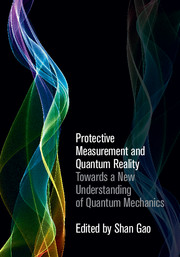Book contents
- Frontmatter
- Dedication
- Contents
- List of Contributors
- Preface
- Acknowledgements
- 1 Protective measurement: an introduction
- Part I Fundamentals and applications
- 2 Protective measurement of the wave function of a single system
- 3 Protective measurement, postselection and the Heisenberg representation
- 4 Protective and state measurement: a review
- 5 Determination of the stationary basis from protective measurement on a single system
- 6 Weak measurement, the energy–momentum tensor and the Bohm approach
- Part II Meanings and implications
- Index
- References
4 - Protective and state measurement: a review
from Part I - Fundamentals and applications
Published online by Cambridge University Press: 05 January 2015
- Frontmatter
- Dedication
- Contents
- List of Contributors
- Preface
- Acknowledgements
- 1 Protective measurement: an introduction
- Part I Fundamentals and applications
- 2 Protective measurement of the wave function of a single system
- 3 Protective measurement, postselection and the Heisenberg representation
- 4 Protective and state measurement: a review
- 5 Determination of the stationary basis from protective measurement on a single system
- 6 Weak measurement, the energy–momentum tensor and the Bohm approach
- Part II Meanings and implications
- Index
- References
Summary
In this chapter, I summarize the general way in which the measurement process can be cast (by making use of effects and amplitude operators). Then, I show that there are two main problems with the state measurement: (i) how to avoid the disruptive back action on the state of the measured system during detection and (ii) how to extract complete information from this state. In order to deal with them I first introduce quantum non-demolition (QND) measurement and examine the problem whether the entire probability distribution of the measured observable is not altered by a QND measurement, which would allow repeated QND measurements with different observables to extract the whole information from the measured system. However, I show that this is not the case. Then, I deal with protective measurement as such and show that a reversible measurement is in fact not a measurement. However, by taking advantage of statistical methods (and therefore by renouncing measurement of the state of a single system), we can indeed reconstruct the wave function but only by partially recovering the information contained in the state. Two further prices to pay are to admit the existence of negative quasi-probabilities due to the interference terms and to make use of unsharp observables for guaranteeing informational completeness.
Introduction
The aim of this chapter is a review of the developments related to the measurement of the state vector and the problems that have been raised in this context.
Traditionally, the state vector or the wave function describing quantum systems has been considered as a formal tool for calculating the probabilities associated with certain events like measurement outcomes, but few scholars have tried to attribute to it an ontological status. It is well known how many difficulties are related to an attempt at assigning a kind of reality to the state of quantum systems.
- Type
- Chapter
- Information
- Protective Measurement and Quantum RealityTowards a New Understanding of Quantum Mechanics, pp. 39 - 62Publisher: Cambridge University PressPrint publication year: 2015
References
- 1
- Cited by



